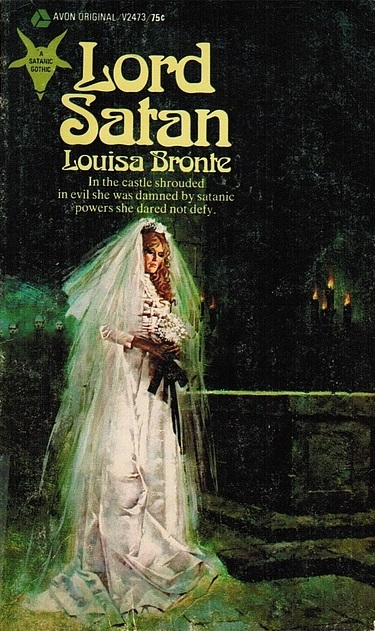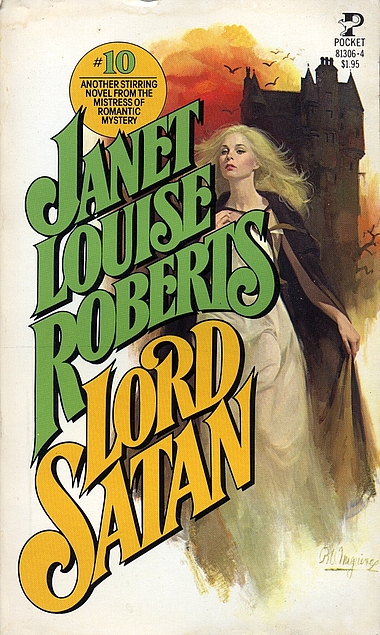
“Oh—it is so huge—so very big,” she whispered, aghast.
Thus spoken is Adrienne’s deliciously Freudian description of Castle Caudill, home to her cousin Lord Vincent Stanton. Vincent is known as “Lord Satan” among the locals because of his ferocious temper and cruelty. Also he performs black masses in the cellar and is on friendly terms with Lucifer. But Adrienne finds all that out later, after marrying her cousin unwittingly in a demonic ceremony. “Unwittingly” is a bit of an understatement, she was drugged and unconscious at the time.
Adrienne does love Vincent, though, so she’s in a terrible pickle. It’s that classic situation of trying to domesticate your husband’s embarrassingly diabolical behavior—only in this case, he literally is a demon. Can the tender heart of a woman soothe the blackened soul of a fiend, or will Adrienne succumb to temptation and willingly join the satanic rituals?
Lord Satan was first published in 1972 as part of the short-lived “Satanic Gothic” series from Avon. These books largely follow the formulas of Gothic classics like Jane Eyre and The Mysteries of Udolpho, only with less ambiguous sex and more horror/Satanism. Charles Manson was a constant presence in the news at the time, causing anxiety and intrigue by the possibility that devils walked among us. Apparently the Gothic way to process such real-life horrors was to marry them and see what happens. At least that’s what goes down in Lord Satan.
The result is a rough but relentlessly juicy novel, possibly made even better by its many flaws. The prose is uninspired, the characters ridiculous and the plot absurd, but the Gothic formula—escalated as it is—remains a treat. Something insane happens every chapter and, in the end, there’s a lot to ponder. Often fiction that is so unrecognizable from our reality is the best lens to see the world for what it really is.
After a few chapters I stopped reading this book as frilly pulp fun and started analyzing its deeper layers, however unintentional they may have been. Picture this all going down as an internal book club:
Lord Satan Book Club Discussion Questions
Vincent has a habit of giving his wife “toys,” tucking her into bed and sending her off to play in a little house called “the fantasy.” Adrienne is a young bride, but not a baby. Why does he do this? What effect does the author create with so much imagery of infantilization?
For me, this amplified the horror aspects of the novel. Although Adrienne is an oblivious character, we readers can easily see how Vincent is manipulating her for his sinister purposes. By “dumbing” her down, so to speak, there is a greater sense of unease at watching her become increasingly entangled in a spider’s web.
An alternative perspective could argue that these elements increase the novel’s erotic attributes. Anne Rice and other feminist writers have noted that with the gain of more equal social standing, there is an increased appetite for erotica depicting women being overpowered. The dominatrix, for example, belittles men much to their delight. But men have enjoyed social dominance for eons. In 1972, amid a swirl of Women’s Liberation ideology, perhaps Lord Satan appeals to a new generation of empowered women readers who find it thrilling to imagine themselves as a powerless heroine ravished by a man with little sense of respect. It is no coincidence, I think, that The Flame and the Flower, the first “bodice ripper,” was also published in 1972.
The question “Can a devil do good works? Can a good man do evil?” becomes a theme of the novel. How does the behavior of priests and devils impact our beliefs about good and bad people? How might readers in 1972 interpret this theme differently than we do today?
This theme feels like the classic mantra of a “cautionary tale.” There’s a long tradition in Gothic literature where choosing a husband becomes a potentially deadly endeavor. One suitor might actually love you, but the other might be plotting your murder so he can take your inheritance. Often appearances can be deceiving, with disfigured suitors actually being the “good” choice over a typical hunk. This theme seems another variation on that sentiment, where the heroine learns a lesson that you really can’t trust anybody.
It’s also worth noting, however, that Janet Louise Roberts was born to a missionary family. I have a similar background, with parents who led a small church. This vantage allows us to see the evil and hypocrisy of religious institutions up close and personal. Some PKs (pastor kids) drink the Kool-Aid and become absorbed into the culture, but I think most of us have an inside understanding that the Wizard of Oz is just a little man behind a curtain.
Today there’s also broad knowledge about the epidemic of molestation covered-up by various churches. Because of this, it’s hardly a surprise to find out that the priest in Lord Satan is actually the one who’s raping and murdering children on the moors. But in 1972, I think that would have been a far edgier reveal. For many back then, God was good and non-God was bad. It’s actually delightfully salacious to see a novel that dares to suggest there is a reality somewhere in between.

What role does the ghost of Vincent’s mother play? How does the voice of a dead, older generation impact Adrienne’s decision making?
I think about this dilemma ALL THE TIME in real life. I’ll hear myself judging something or not pursuing what I want to do because ghostly voices from a bygone era—probably Victorian—are telling me how to live my life. It’s terrifying! How many of my thoughts are actually my thoughts and how many are a hodgepodge of hand-me-down expectations?
The voice of Vincent’s mother 100% impacts Adrienne’s frame of mind, causing her to ignore major red flags (like human sacrifices in the cellar) and continue romantic pursuit of a demon. Admittedly I’m taking the side that Vincent is not so great a catch. Someone else could argue he’s a dreamboat. Ultimately, though, Adrienne finds herself in a situation she’d rather not be in because she listens to a dead woman who also made bad decisions. Had she trusted her instincts, she might have found herself in a better position.
Of course, then the question becomes where do her instincts come from? They too are probably made up of the opinions and morals of others. As a very naïve and uneducated character, Adrienne really lacks the ability to make any decision for herself. For such a person, taking advice might ordinarily be a good idea—except when everyone around you is a horrible person.
Does the novel glamorize injustices toward women or expose them?
This is another question that depends on your interpretation of the novel. I believe the author more likely intended the book to expose the horrors that can befall women when they do not learn to think or stand up for themselves. I would totally accept the other interpretation, however, that it does use real-life horrors (such as marital rape) and repackage them as sexual awakening fantasy. No judgment here, though. I get how one person’s nightmare can be another’s wet dream. That the novel can be read in so many different ways shows a level of complexity greater than one would typically expect from a Gothic romance.
What do you expect will happen next for Adrienne, Vincent, and their son?
I may be a pessimist, but I think the most likely scenario is that now that Vincent has an heir, he will embrace his demon tendencies even more. The kindness he’d shown recently will evaporate and he will return to his true self. Having gotten what he wanted from Adrienne, she will be completely useless to him except for sex, which will probably grow increasingly violent and unpleasant. The only way out of perpetual misery will be to become a demon. If she refuses to do that, she will kill herself instead. Again, I may be a pessimist.
But that’s my interpretation of the novel as a cautionary tale. My basis for this is that I feel the author made Adrienne abundantly clueless by design so that the reader can “learn” from her mistakes.
As always, I would gladly accept someone else’s more positive interpretation. In the end, I think it was a brilliant move to conclude the novel exactly as it does. No, there’s not a clear resolution, but it allows readers either to view the novel as a horror story or a romance, whatever they’re in the mood for that day.
Overall…
For a seemingly frilly 159-page novel, Lord Satan provides a lot to analyze. No surprise that the “Satanic Gothic” series, which includes other provocative titles like Vengeance of the Cat Goddess, The Devil’s Dance and Her Demon Lover, are—today, at least—among the most cherished and sought-after Gothic Romance paperbacks ever published. There’s even an Instagrammer who tattooed the series’ horned-goat logo to her body. Talk about dedication!
I didn’t love Lord Satan that much, but I appreciated its multifaceted storyline and escalation of Gothic tropes. Count me in for reading more from Janet Louise Roberts (aka Louisa Bronte aka Janette Radcliffe aka Rebecca Danton) and all the books from this series.
Don’t miss our latest content! SpookyBooky is on social media:
